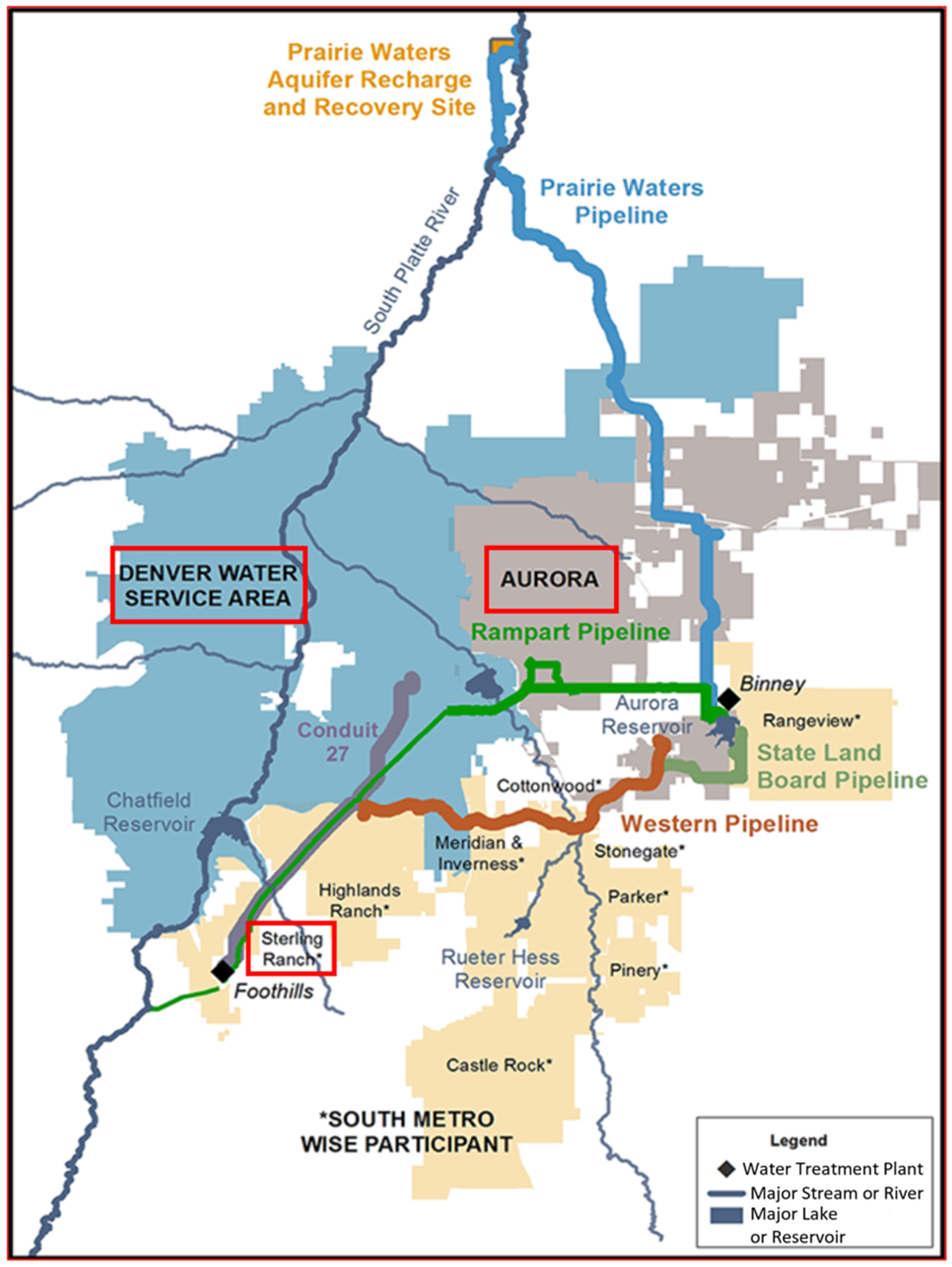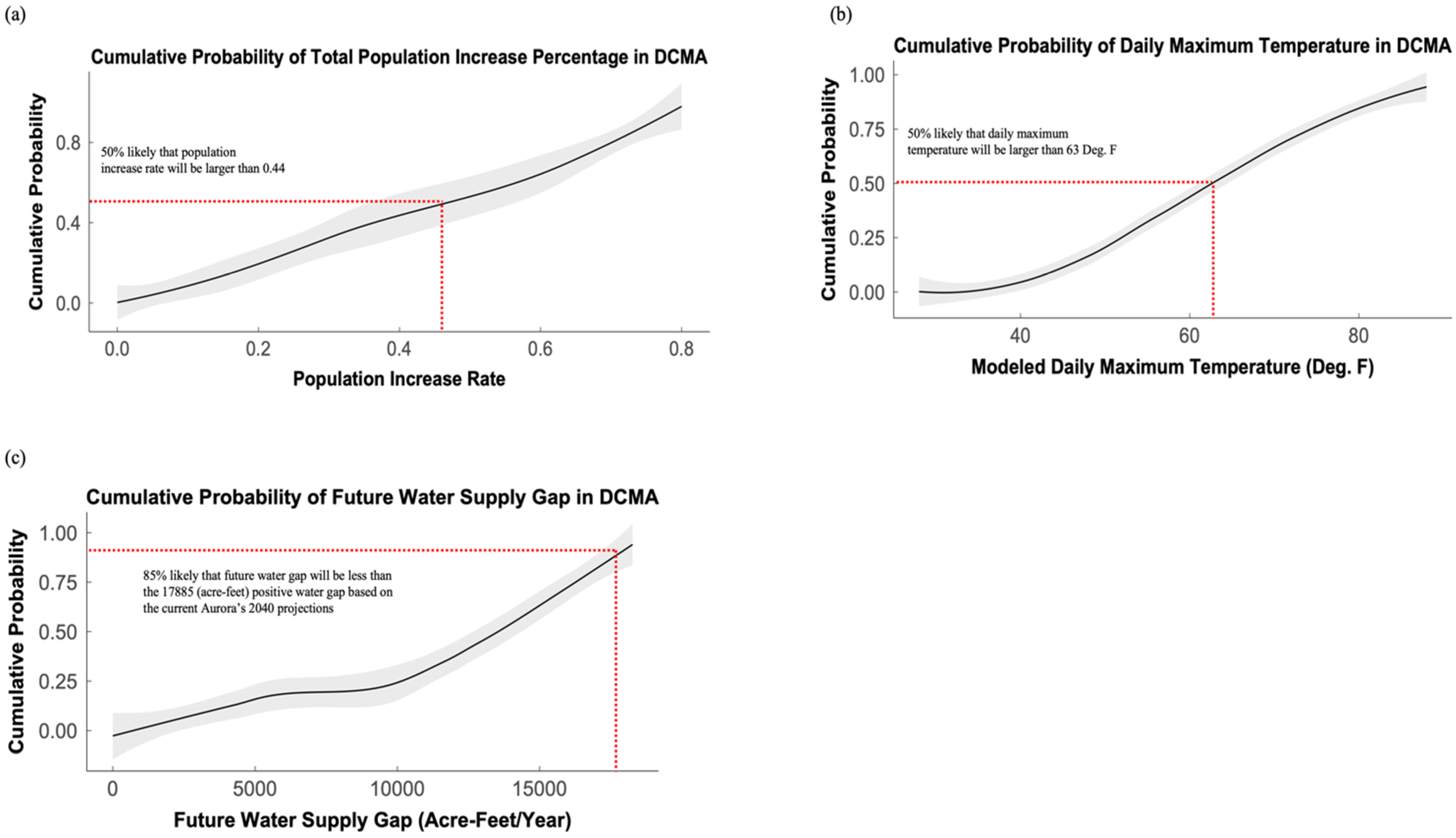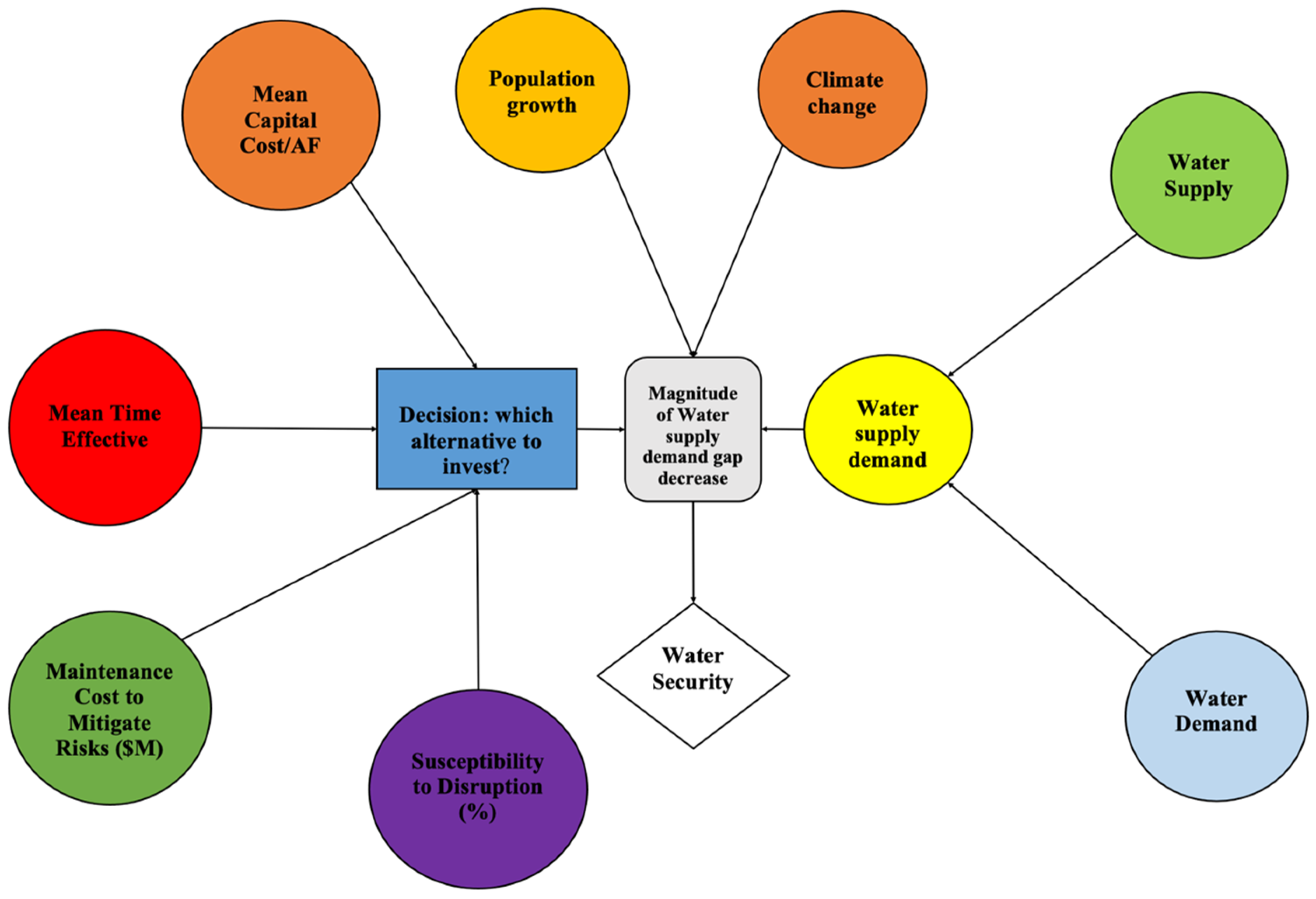Evaluation of Future-Integrated Urban Water Management Using a Risk and Decision Analysis Framework: A Case Study in Denver–Colorado Metro Area (DCMA)
Abstract
:1. Introduction
2. Methods
2.1. Study Area
- Water rights limitations: The critical issue of fully encumbered water rights in Douglas County has created a barrier to new developments in acquiring water supply. Without the possibility of accessing additional rights, new developers must resort to alternative strategies to meet the water demand of their projects.
- Reliance on groundwater: Douglas County’s heavy reliance on groundwater, particularly from the Denver Basin Aquifer, poses sustainability challenges due to its limited or negligible annual recharge. Decreasing this dependence is contingent on the exploration of new surface water resources.
- Diversified water management approaches: Dominion Water has adopted a multi-pronged approach to meet the water demand of Sterling Ranch. This includes utilizing junior rights to surface flows, reclaimed effluent, groundwater, potential rainwater harvesting, and the purchase of WISE water, reflecting a comprehensive strategy that integrates multiple water sources.
- WISE partnership [22]: The Water Infrastructure Supply and Efficiency partnership, involving Aurora Water, Denver Water, and several communities in the Douglas County South Metro Water Supply Authority, including Dominion Water, highlights the collaborative effort to manage and distribute water resources efficiently. This intergovernmental agreement aims to optimize the use of water resources and ensure that excess water from Aurora and Denver is made available to other participating communities.
- Long-term implications: While developers and water providers initially bear the capital risk, the long-term implications of water management fall on customers who will face potential challenges related to utilities and fees.
2.2. Risk Analysis
2.3. Decision Analysis
2.3.1. Multiple Attribute Value Theory (MAVT)
2.3.2. Analytic Hierarchy Process (AHP)
3. Results and Discussion
3.1. Risk and Uncertainty Analysis
3.2. Decision Analysis
4. Conclusions and Future Direction
Supplementary Materials
Author Contributions
Funding
Data Availability Statement
Acknowledgments
Conflicts of Interest
References
- Maddocks, A.; Reig, P. World’s 18 Most Water-Stressed Rivers. Available online: https://www.wri.org/insights/worlds-18-most-water-stressed-rivers (accessed on 1 October 2023).
- Hernández-Cruz, A.; Sandoval-Solís, S.; Mendoza-Espinosa, L.G.; Ramírez-Hernández, J.; Medellín-Azuara, J.; Daesslé, L.W. Assessing Water Management Strategies under Water Scarcity in the Mexican Portion of the Colorado River Basin. J. Water Resour. Plan. Manag. 2023, 149, 04023042. [Google Scholar] [CrossRef]
- Nations Unies. World Water Assessment Programme; The United Nations World Water Development Report 2018; United Nations Educational, Scientific and Cultural Organization: New York, NY, USA, 2018; Available online: www.unwater.org/publications/world-water-development-report-2018/ (accessed on 12 November 2023).
- Boretti, A.; Rosa, L. Reassessing the projections of the world water development report. NPJ Clean Water 2019, 2, 15. [Google Scholar] [CrossRef]
- Richter, B.D. Decoupling urban water use from population growth in the Colorado River basin. J. Water Resour. Plan. Manag. 2023, 149, 04022082. [Google Scholar] [CrossRef]
- Hung, F.; Son, K.; Yang, Y.E. Investigating uncertainties in human adaptation and their impacts on water scarcity in the Colorado river Basin, United States. J. Hydrol. 2022, 612, 128015. [Google Scholar] [CrossRef]
- He, B.; Ding, K.J. Global greenhouse gases emissions effect on extreme events under an uncertain future: A case study in Western Cape, South Africa. PLOS Clim. 2023, 2, e0000107. [Google Scholar] [CrossRef]
- He, B. Efficient Computational Evaluation Tools to Accelerate the Planning of Vulnerability, Resilience, and Sustainability of the Social-Environmental Systems in the City of Nashville. Ph.D. Dissertation, Vanderbilt University, Nashville, TN, USA, May 2023. [Google Scholar]
- He, B.; Gilligan, J.M.; Camp, J.V. An index of social fabric for assessing community vulnerability to natural hazards: Model development and analysis of uncertainty and sensitivity. Int. J. Disaster Risk Reduct. 2023, 103913. [Google Scholar] [CrossRef]
- Rossi, G.; Peres, D.J. Climatic and other global changes as current Challenges in improving Water Systems Management: Lessons from the case of Italy. Water Resour. Manag. 2023, 37, 2387–2402. [Google Scholar] [CrossRef]
- Christensen, N.S.; Wood, A.W.; Voisin, N.; Lettenmaier, D.P.; Palmer, R.N. The effects of climate change on the hydrology and water resources of the Colorado River basin. Clim. Change 2004, 62, 337–363. [Google Scholar] [CrossRef]
- Peters, C.N.; Baroud, H.; Hornberger, G.M. Multicriteria decision analysis of drinking water source selection in southwestern Bangladesh. J. Water Resour. Plan. Manag. 2019, 145, 05019004. [Google Scholar] [CrossRef]
- Bognár, F.; Benedek, P. A novel AHP-PRISM risk assessment method—An empirical case study in a nuclear power plant. Sustainability 2022, 14, 11023. [Google Scholar] [CrossRef]
- Zhang, F.; Wang, P.; Mu, P.; Wang, M.; Han, L.; Sun, J. A comprehensive evaluation method for the service status of groins in waterways based on an AHP-improved CRITIC combination weighting optimization model. Sustainability 2022, 14, 10709. [Google Scholar] [CrossRef]
- He, B.; Guan, Q. A Risk and Decision Analysis Framework to Evaluate Future PM2.5 Risk: A Case Study in Los Angeles-Long Beach Metro Area. Int. J. Environ. Res. Public Health 2021, 18, 4905. [Google Scholar] [CrossRef] [PubMed]
- Lai, Olivia. The Looming Colorado Water Shortage Crisis. Climate Change, Policy & Economics at Earth.org. Available online: https://earth.org/colorado-water-shortage/ (accessed on 1 October 2023).
- Sullivan, A.; White, D.D.; Larson, K.L.; Wutich, A. Towards water sensitive cities in the Colorado River Basin: A comparative historical analysis to inform future urban water sustainability transitions. Sustainability 2017, 9, 761. [Google Scholar] [CrossRef]
- Star, Indianapolis. Denver-Aurora-Lakewood, CO Metro Area Demographics and Housing 2020 Decennial Census. Indianapolis Star. Available online: https://data.indystar.com/census/total-population/total-population-change/denver-aurora-lakewood-co-metro-area/320-19740/ (accessed on 1 October 2023).
- Aurora Water. Municipal Water Efficiency Plan Aurora Water City of Aurora, Colorado. Aurora Water. Available online: chrome-extension://efaidnbmnnnibpcajpcglclefindmkaj/https://cdnsm5-hosted.civiclive.com/UserFiles/Servers/Server_1881137/File/Residents/Water/Water%20System/Aurora%20Water%20Facts/Final_2015_ConservationPlan_update_3.18.16.pdf (accessed on 1 November 2023).
- Douglas County. Available online: http://www.douglas.co.us/water/water-supply/ (accessed on 12 November 2023).
- Colorado Water Plan. Available online: https://www.colorado.gov/pacific/cowaterplan/colorados-water-plan-final-2015 (accessed on 14 November 2023).
- WISE Agreement. WISE Partnership-Water Delivery Agreement between Denver Water, the City of Aurora, Acting by and through its Utility Enterprise, and the South Metro Water Supply Authority. City of Aurora, Colorado. Available online: https://www.sec.gov/Archives/edgar/data/276720/000110262415000024/exh10_3.htm (accessed on 1 November 2023).
- Angelis, A.; Kanavos, P. Multiple criteria decision analysis (MCDA) for evaluating new medicines in health technology assessment and beyond: The advance value framework. Soc. Sci. Med. 2017, 188, 137–156. [Google Scholar] [CrossRef] [PubMed]
- Saaty, T.L. Multicriteria Decision Making: The Analytic Hierarchy Process; RWS Publications: Pittsburgh, PA, USA, 1992. [Google Scholar]
- Saaty, T.L. Decision making with the analytic hierarchy process. Int. J. Serv. Sci. 2008, 1, 83–98. [Google Scholar] [CrossRef]
- Macrotrends. Denver Metro Area Population 1950–2023. Available online: https://www.macrotrends.net/cities/22972/denver/population#:~:text=The%20current%20metro%20area%20population,a%201.22%25%20increase%20from%202021 (accessed on 1 October 2023).
- Payne, T.; Smith, M.; Landry, C. Price Determination and Efficiency in the Market for South Platte Basin Ditch Company Shares. J. Am. Water Resour. Assoc. 2014, 50, 1488–1500. [Google Scholar] [CrossRef]
- Choy, I.; McGhee, G.; Rohde, M. Recharge: Groundwater’s Second Act. Water in the West. Stanford Woods Institute for the Environment. Available online: http://waterinthewest.stanford.edu/groundwater/recharge/ (accessed on 16 October 2023).
- Yates, D.N.; Miller, K.A.; Wilby, R.L.; Kaatz, L. Decision-centric adaptation appraisal for water management across Colorado’s continental divide. Clim. Risk Manag. 2015, 10, 35–50. [Google Scholar] [CrossRef]
- Cosgrove, W.J.; Loucks, D.P. Water management: Current and future challenges and research directions. Water Resour. Res. 2015, 51, 4823–4839. [Google Scholar] [CrossRef]








| Future Water Supply–Demand Risk Factor | ||
|---|---|---|
| Gap (Acre-Feet/Year) | Decrease rate * | Decrease Level * |
| 30–50% | High | |
| 15–30% | Medium | |
| 0–15% | Low | |
| Factors | Increase Rate * | Definition of Increase Level * |
| Population | 30–50% | High |
| 15–30% | Medium | |
| 8–15% | Low | |
| Temperature | 2–3% | High |
| 1–2% | Medium | |
| 0–1% | Low |
| Decrease Level | Decrease Rate | Water Supply–Demand Gap Decrease |
|---|---|---|
| High | 50% | 8943 (Acre-Feet/Year) |
| Medium | 30% | 5366 (Acre-Feet/Year) |
| Low | 20% | 2683 (Acre-Feet/Year) |
| P [Stress = High|Risk Factor = (High, Medium, Low)] | P (Risk Factor = High|Stress = High) |
| P (stress = high|population growth = high) = 0.64 | P (population growth = high|stress = high) = 0.6147 |
| P (stress = high|population growth = medium) = 0.09 | |
| P (stress = high|population growth = low) = 0 | |
| P (stress = high|temperature increase = high) = 0.687 | P (temperature increase = high|stress = high) = 0.8012 |
| P (stress = high|temperature increase = medium) = 0.042 | |
| P (stress = high|temperature increase = low) = 0 | |
| P (stress = high|water supply–demand gap decrease = high) = 0.286 | P (water supply–demand gap decrease = high|stress = high) = 0.1373 |
| P (stress = high|water supply–demand gap decrease = medium) = 0.205 | |
| P (stress = high|water supply–demand gap decrease = low) = 0.238 |
| Alternative | Risks | Mean Capital Cost per Acre-Foot (AF) | High Negative Water Gap * | Medium Negative Water Gap * | Low Negative Water Gap * | Cost Range |
|---|---|---|---|---|---|---|
| Purchase Water Rights | Junior rights; competing agricultural needs; timing of availability; susceptibility to disruption | $7417 ** | 8943 AF | 5366 AF | 2683 AF | $20–66 M |
| Ground Water Pumping and Recharge | Efficacy and cost of recharge; impacts to human health; susceptibility to disruption | $3795 ** | 8943 AF | 5366 AF | 2683 AF | $10–34 M |
| Expand Existing Storage Reservoirs | Need for infrastructure; impacts to environment; susceptibility to disruption | $2200 ** | 8943 AF | 5366 AF | 2683 AF | $5–19 M |
| Mean Capital Cost (USD Million) | Rank |
|---|---|
| 5–20 | 1 |
| 21–35 | 2 |
| 36–50 | 3 |
| 51–65 | 4 |
| 66–80 | 5 |
| Mean Time to be Effective (Years) | Rank |
| 0–5 | 1 |
| 6–10 | 2 |
| 11–15 | 3 |
| 16–20 | 4 |
| 21–25 | 5 |
| Maintenance Cost to Mitigate Risks (USD Million) | Rank |
| 0–5 | 1 |
| 6–10 | 2 |
| 11–15 | 3 |
| 16–20 | 4 |
| 21–25 | 5 |
| Susceptibility to Disruption (%) | Rank |
| 0–20 | 1 |
| 21–40 | 2 |
| 41–60 | 3 |
| 61–80 | 4 |
| 81–100 | 5 |
Disclaimer/Publisher’s Note: The statements, opinions and data contained in all publications are solely those of the individual author(s) and contributor(s) and not of MDPI and/or the editor(s). MDPI and/or the editor(s) disclaim responsibility for any injury to people or property resulting from any ideas, methods, instructions or products referred to in the content. |
© 2023 by the authors. Licensee MDPI, Basel, Switzerland. This article is an open access article distributed under the terms and conditions of the Creative Commons Attribution (CC BY) license (https://creativecommons.org/licenses/by/4.0/).
Share and Cite
He, B.; Zheng, H.; Guan, Q. Evaluation of Future-Integrated Urban Water Management Using a Risk and Decision Analysis Framework: A Case Study in Denver–Colorado Metro Area (DCMA). Water 2023, 15, 4020. https://doi.org/10.3390/w15224020
He B, Zheng H, Guan Q. Evaluation of Future-Integrated Urban Water Management Using a Risk and Decision Analysis Framework: A Case Study in Denver–Colorado Metro Area (DCMA). Water. 2023; 15(22):4020. https://doi.org/10.3390/w15224020
Chicago/Turabian StyleHe, Bowen, Han Zheng, and Qun Guan. 2023. "Evaluation of Future-Integrated Urban Water Management Using a Risk and Decision Analysis Framework: A Case Study in Denver–Colorado Metro Area (DCMA)" Water 15, no. 22: 4020. https://doi.org/10.3390/w15224020
APA StyleHe, B., Zheng, H., & Guan, Q. (2023). Evaluation of Future-Integrated Urban Water Management Using a Risk and Decision Analysis Framework: A Case Study in Denver–Colorado Metro Area (DCMA). Water, 15(22), 4020. https://doi.org/10.3390/w15224020






